Techniques
Center for Organic Synthesis
Techniques
The Center utilizes several organic Synthesis and analytical techniques such as GC QQQ/MS, LC/MS/MS, TG DSC and Multi Nuclear 400 MHz -NMR Spectrometer.
The Center utilizes several organic Synthesis and analytical techniques such as GC QQQ/MS, LC/MS/MS, TG DSC and Multi Nuclear 400 MHz -NMR Spectrometer.
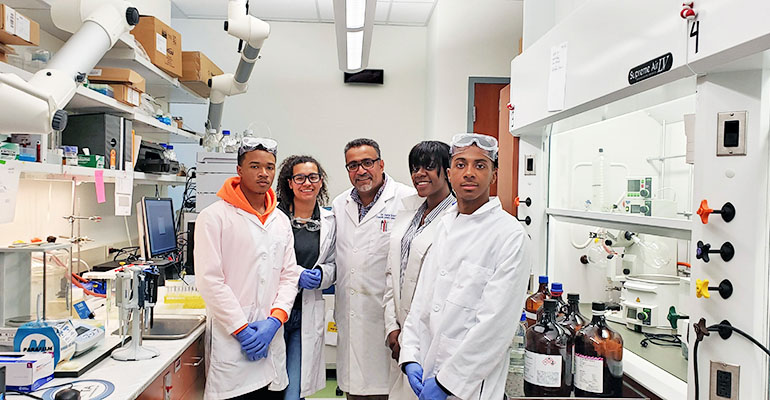
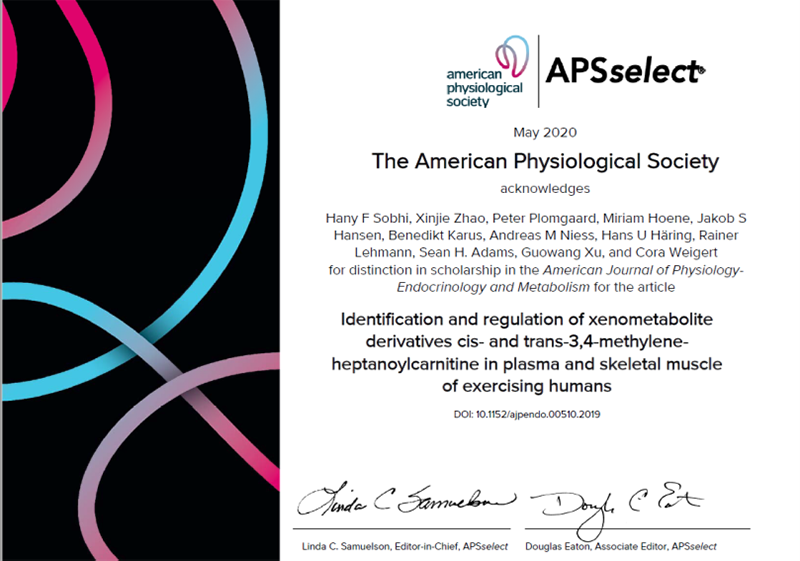
For the past four years we have published three publications with the Journal of Physiology-Endocrinology and Metabolism and we received National Honorary Recognition, from the American Physiological Society as the best published article in Physiological Research in 2020. Publication Titled: Identification and regulation of xenometabolite derivatives cis- and trans-3,4-methylene-heptanoylcarnitine in plasma and skeletal muscle of exercising humans, By: Hany F. Sobhi, Xinjie Zhao, Peter Plomgaard, Sean Adams et al and published to the American Journal of Physiology-Endocrinology and Metabolism https://doi.org/10.1152/ajpendo.00510.2019, PubMed32101032, February 26, 2020. This Publication has been selected by the American Physiological Society for APSselect (http://apsselect.physiology.org/).


For the past four years we have published three publications with the Journal of Physiology-Endocrinology and Metabolism and we received National Honorary Recognition, from the American Physiological Society as the best published article in Physiological Research in 2020. Publication Titled: Identification and regulation of xenometabolite derivatives cis- and trans-3,4-methylene-heptanoylcarnitine in plasma and skeletal muscle of exercising humans, By: Hany F. Sobhi, Xinjie Zhao, Peter Plomgaard, Sean Adams et al and published to the American Journal of Physiology-Endocrinology and Metabolism https://doi.org/10.1152/ajpendo.00510.2019, PubMed32101032, February 26, 2020. This Publication has been selected by the American Physiological Society for APSselect (http://apsselect.physiology.org/).
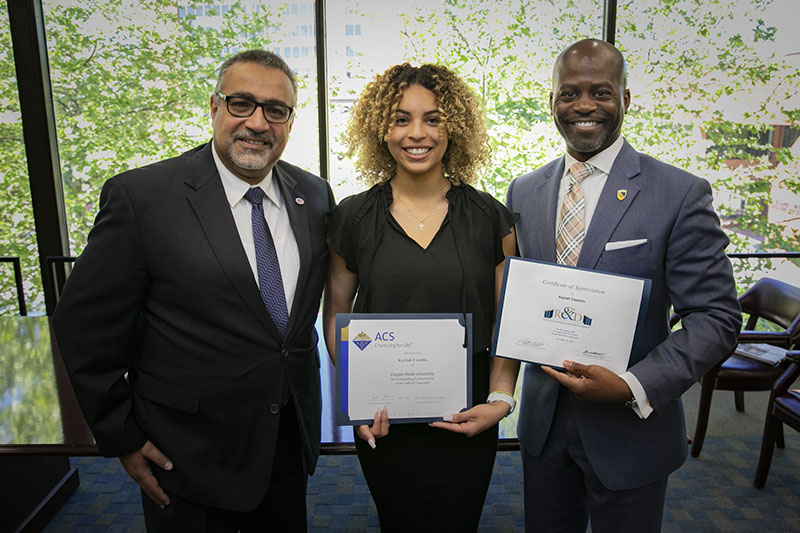
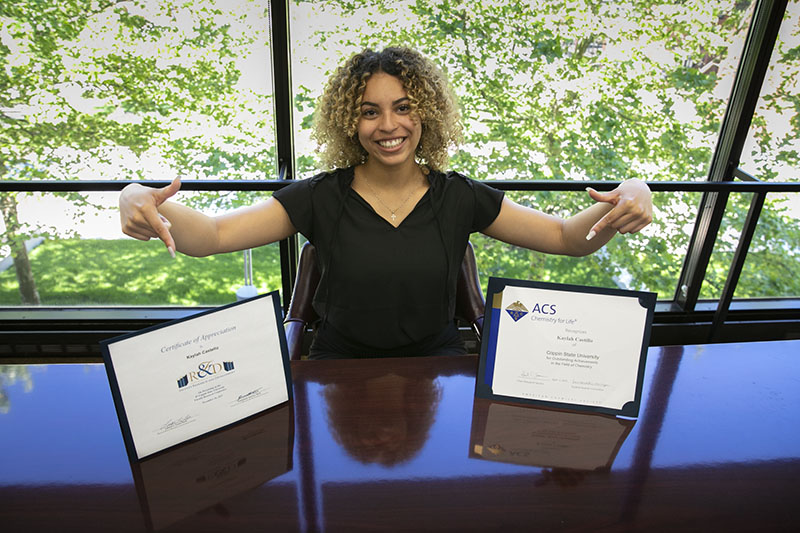
Ms. Kaylah Castillo (Senior, Biology and Chemistry Major) was awarded at the 2022 American Chemical Society's 44th Annual Student Award Ceremony for excellence in undergraduate research in chemistry. Ms. Castillo also presented at the R&D Faculty Annual Research Conference held November 18, 2021. Her research involves the extraction and characterization of Cyclopropyl lipids and fatty acids using LCMS analysis.
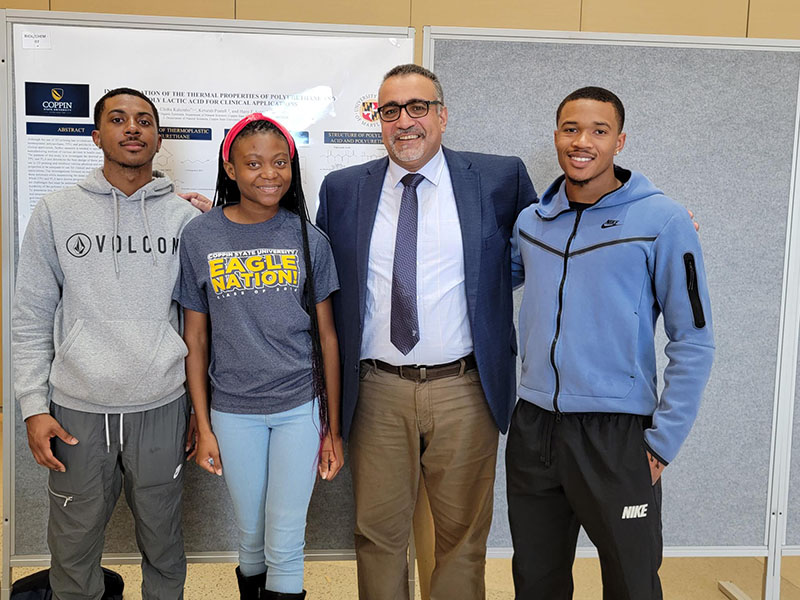
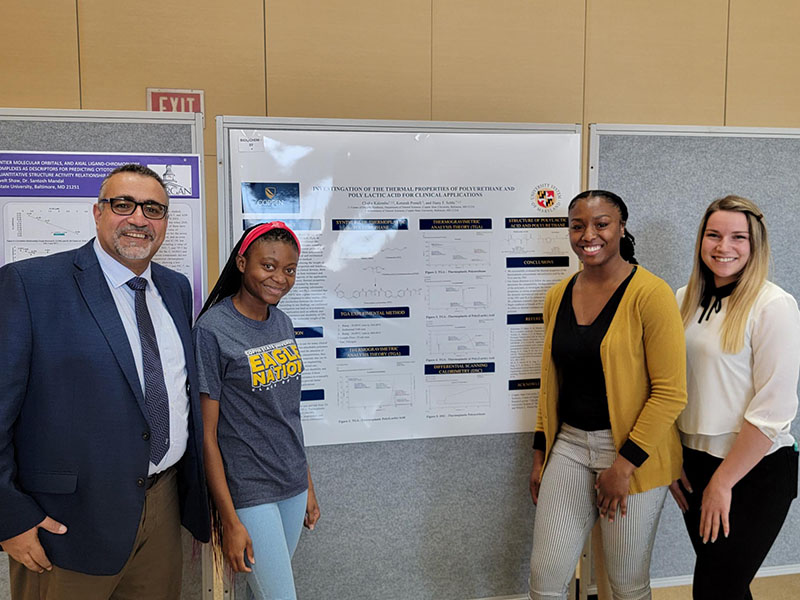
April 2022: Professor Hany Sobhi along with students C. Kalembo and K. Postell present Investigation of the Thermal Properties of Polyurethane and Poly Lactic Acid for Clinical Applications at the research conference at Morgan State University.
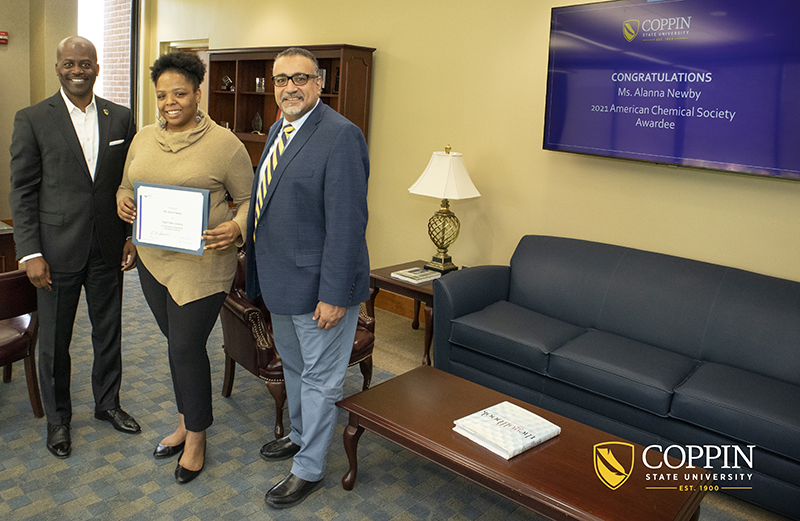
President Jenkins and Dr. Hany Sobhi stand alongside Ms. Alanna Newby, the 2021 American Chemical Society (ACS) Awardee for outstanding achievements in the field of chemistry.
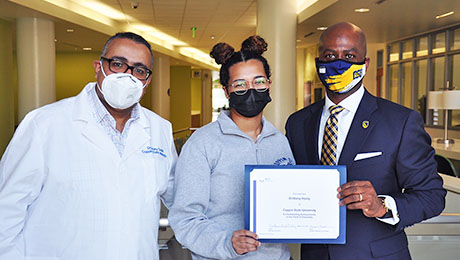
Sunday, March 29, 2020: Ms. Brittany Henly (Junior, Chemistry Major) awarded at the American Chemical Society's 42nd Annual Student Award Ceremony for excellence in undergraduate research in chemistry. Ms. Henly's research involves the synthesis and characterization of medium chain fatty acids using GCMS, NMR analysis.
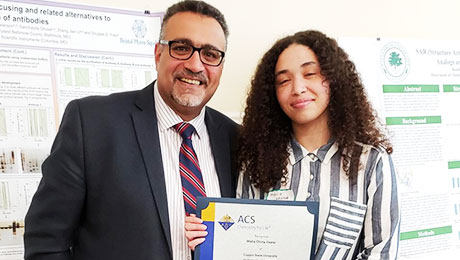
Sunday, April 14, 2019: Ms. Malia Vester (Senior, Chemistry Major) awarded at the American Chemical Society Award Ceremony for excellence in undergraduate research in chemistry at Notre Dame of Maryland in Baltimore, MD. Ms. Vester's research involves the detection of THM in drinking water using GCMS analysis. She published her first paper where she is the first author.
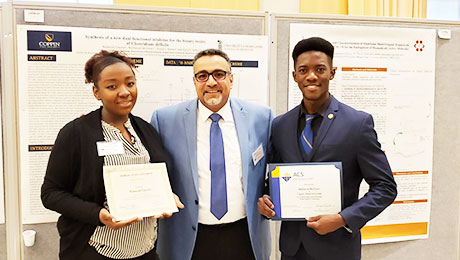
Thursday, April 11, 2019: Research students Ms. Nataejah Clayton (Senior), and Mr. Nathaniel McClean (Junior, Chemistry Major) presented their research poster at the 24th MSU Research Student Symposium in Baltimore, MD.
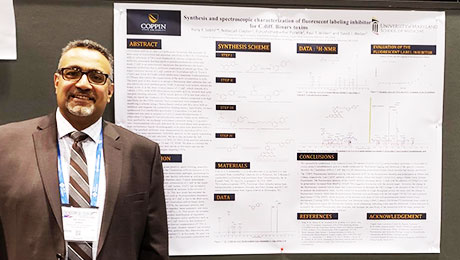
Tuesday, April 2, 2019: Dr. Sobhi presents his recent data finding in the development of Fluorescence inhibitor for Cdiff binary toxin at the 257 American Chemical Society National Conference, in Orlando, Florida.
2016: Dr. Sobhi receives the 2015-2016 University System of Maryland (USM) Board Of Regents Faculty Award for Excellence in Scholarship, Research, and Creative Activity.
2016: Anster Charles receives American Chemical Society (ACS) Award for Outstanding Undergraduate Student in Chemistry
2015: Coppin Professor Hany F. Sobhi wins Wilson H. Elkins Professorship award by University System of Maryland for Advances in Research
2013: NASA - NAI- MIRS Astrobiology Faculty Incentive Research Award
2012: 2012 NASA - NAI- Astrobiology Faculty Fellowship program / Faculty Scholar Research Award
2011: American Association for Cancer Research, AACR Faculty Scholar in Cancer Research Award
2011: Distinguished Faculty research and development Award, from Coppin State University Research Council
2009: 2009 Postdoctoral Research Award, Research Showcase -2009 Case western Reserve University
2007: F.C. Mark Graduate Teaching Assistantship Award For Excellence in Teaching Organic Chemistry
2007: North East Ohio Science and Engineering Fair (NEOSEF) - Dr. Hany Sobhi participated in the judging for the American Chemical Society special awards in chemistry projects on March 13, 2007.
2007: Doctoral Dissertation Research Expense Award, Cleveland State University, University Research Council
2006: F.C. Mark Graduate Teaching Assistantship Award for excellence in teaching NMR and Organic Chemistry Laboratories


Ms. Kaylah Castillo (Senior, Biology and Chemistry Major) was awarded at the 2022 American Chemical Society's 44th Annual Student Award Ceremony for excellence in undergraduate research in chemistry. Ms. Castillo also presented at the R&D Faculty Annual Research Conference held November 18, 2021. Her research involves the extraction and characterization of Cyclopropyl lipids and fatty acids using LCMS analysis.


April 2022: Professor Hany Sobhi along with students C. Kalembo and K. Postell present Investigation of the Thermal Properties of Polyurethane and Poly Lactic Acid for Clinical Applications at the research conference at Morgan State University.

President Jenkins and Dr. Hany Sobhi stand alongside Ms. Alanna Newby, the 2021 American Chemical Society (ACS) Awardee for outstanding achievements in the field of chemistry.

Sunday, March 29, 2020: Ms. Brittany Henly (Junior, Chemistry Major) awarded at the American Chemical Society's 42nd Annual Student Award Ceremony for excellence in undergraduate research in chemistry. Ms. Henly's research involves the synthesis and characterization of medium chain fatty acids using GCMS, NMR analysis.

Sunday, April 14, 2019: Ms. Malia Vester (Senior, Chemistry Major) awarded at the American Chemical Society Award Ceremony for excellence in undergraduate research in chemistry at Notre Dame of Maryland in Baltimore, MD. Ms. Vester's research involves the detection of THM in drinking water using GCMS analysis. She published her first paper where she is the first author.

Thursday, April 11, 2019: Research students Ms. Nataejah Clayton (Senior), and Mr. Nathaniel McClean (Junior, Chemistry Major) presented their research poster at the 24th MSU Research Student Symposium in Baltimore, MD.

Tuesday, April 2, 2019: Dr. Sobhi presents his recent data finding in the development of Fluorescence inhibitor for Cdiff binary toxin at the 257 American Chemical Society National Conference, in Orlando, Florida.
2016: Dr. Sobhi receives the 2015-2016 University System of Maryland (USM) Board Of Regents Faculty Award for Excellence in Scholarship, Research, and Creative Activity.
2016: Anster Charles receives American Chemical Society (ACS) Award for Outstanding Undergraduate Student in Chemistry
2015: Coppin Professor Hany F. Sobhi wins Wilson H. Elkins Professorship award by University System of Maryland for Advances in Research
2013: NASA - NAI- MIRS Astrobiology Faculty Incentive Research Award
2012: 2012 NASA - NAI- Astrobiology Faculty Fellowship program / Faculty Scholar Research Award
2011: American Association for Cancer Research, AACR Faculty Scholar in Cancer Research Award
2011: Distinguished Faculty research and development Award, from Coppin State University Research Council
2009: 2009 Postdoctoral Research Award, Research Showcase -2009 Case western Reserve University
2007: F.C. Mark Graduate Teaching Assistantship Award For Excellence in Teaching Organic Chemistry
2007: North East Ohio Science and Engineering Fair (NEOSEF) - Dr. Hany Sobhi participated in the judging for the American Chemical Society special awards in chemistry projects on March 13, 2007.
2007: Doctoral Dissertation Research Expense Award, Cleveland State University, University Research Council
2006: F.C. Mark Graduate Teaching Assistantship Award for excellence in teaching NMR and Organic Chemistry Laboratories
Research plans designed to monitor protein small molecule (substrate) interactions. This work spans from pure synthetic organic chemistry to qualitative and quantitative monitoring to biochemical reactions. Our research focuses on the synthesis of Bio-organic substrates- (Biomarkers)- Acyl carnitine, and Acyl Coenzyme A, for clinical diagnosis, and the investigation of the reaction mechanism, and intermediates characterization of specific metabolic pathways. Furthermore, we aim to investigate the protein-protein interaction and its influence in diseases progression. Recent efforts focused on critical needs in the area of microbiome biology, and more specifically synthesize and characterize microbe-derived metabolites (xenometabolites). This involves custom synthesis and spectroscopic characterization and full quantification by mass spectrometry of xenometabolites or xenometabolite-derivatives.
Recent research projects focused on the synthesis of specialty-functionalized biodegradable photo polymers and the development of a photochemical strategy for cross-linking biopolymers for scaffolds, coatings and prostheses. We developed a series of phosphine oxides photo initiators that can achieve compatibility with aqueous media with improved performance. This type of initiator is promising in biomedical applications, specifically for Orthopedic, clinical dentistry and bone tissue engineering, since it is relatively nontoxic and may become incorporated innocuously into organic matrices and tissues.
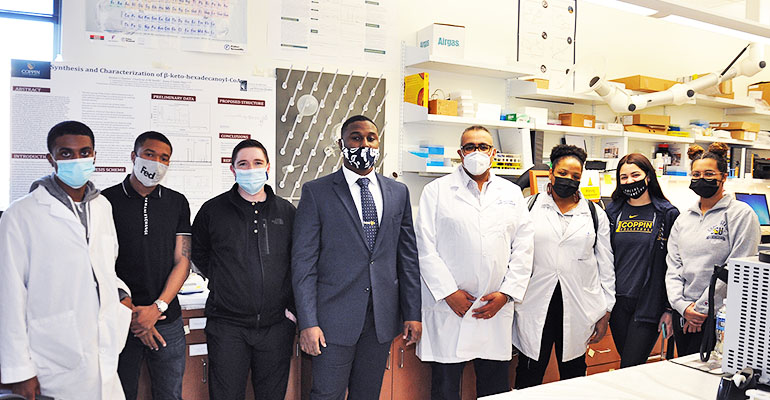
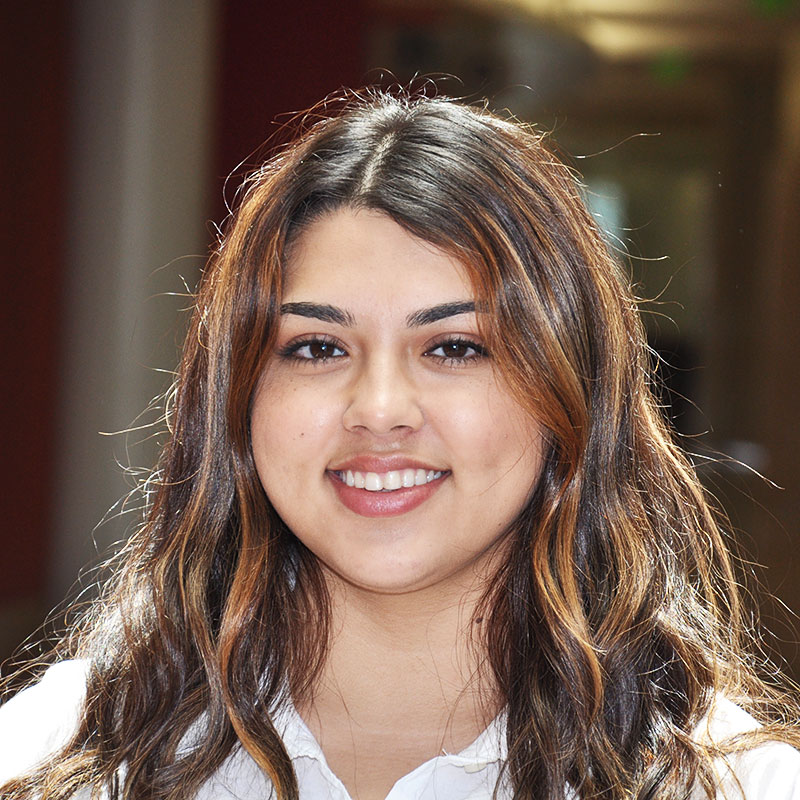
I began working with Dr. Sobhi in the summer of 2019 in the Center for Organic Synthesis in collaboration with the University of Maryland, School of Medicine. This opportunity has opened many doors for me, as well as meet some amazing people. During our time in the lab, I have since been able to gain a better understanding of techniques used in chemical analysis such as, Infrared Spectrometry, Mass Spectrometry, and Nuclear Magnetic Resonance. Mastering these methods have shed some light on new interests and exposed me to new concentrations that I plan to use when furthering my education post-graduation. I am very grateful for this opportunity I was given and the experience I have gained through Dr. Sobhi.
Amanda Robinson, Chemistry Major
Research plans designed to monitor protein small molecule (substrate) interactions. This work spans from pure synthetic organic chemistry to qualitative and quantitative monitoring to biochemical reactions. Our research focuses on the synthesis of Bio-organic substrates- (Biomarkers)- Acyl carnitine, and Acyl Coenzyme A, for clinical diagnosis, and the investigation of the reaction mechanism, and intermediates characterization of specific metabolic pathways. Furthermore, we aim to investigate the protein-protein interaction and its influence in diseases progression. Recent efforts focused on critical needs in the area of microbiome biology, and more specifically synthesize and characterize microbe-derived metabolites (xenometabolites). This involves custom synthesis and spectroscopic characterization and full quantification by mass spectrometry of xenometabolites or xenometabolite-derivatives.
Recent research projects focused on the synthesis of specialty-functionalized biodegradable photo polymers and the development of a photochemical strategy for cross-linking biopolymers for scaffolds, coatings and prostheses. We developed a series of phosphine oxides photo initiators that can achieve compatibility with aqueous media with improved performance. This type of initiator is promising in biomedical applications, specifically for Orthopedic, clinical dentistry and bone tissue engineering, since it is relatively nontoxic and may become incorporated innocuously into organic matrices and tissues.


I began working with Dr. Sobhi in the summer of 2019 in the Center for Organic Synthesis in collaboration with the University of Maryland, School of Medicine. This opportunity has opened many doors for me, as well as meet some amazing people. During our time in the lab, I have since been able to gain a better understanding of techniques used in chemical analysis such as, Infrared Spectrometry, Mass Spectrometry, and Nuclear Magnetic Resonance. Mastering these methods have shed some light on new interests and exposed me to new concentrations that I plan to use when furthering my education post-graduation. I am very grateful for this opportunity I was given and the experience I have gained through Dr. Sobhi.
Amanda Robinson, Chemistry Major
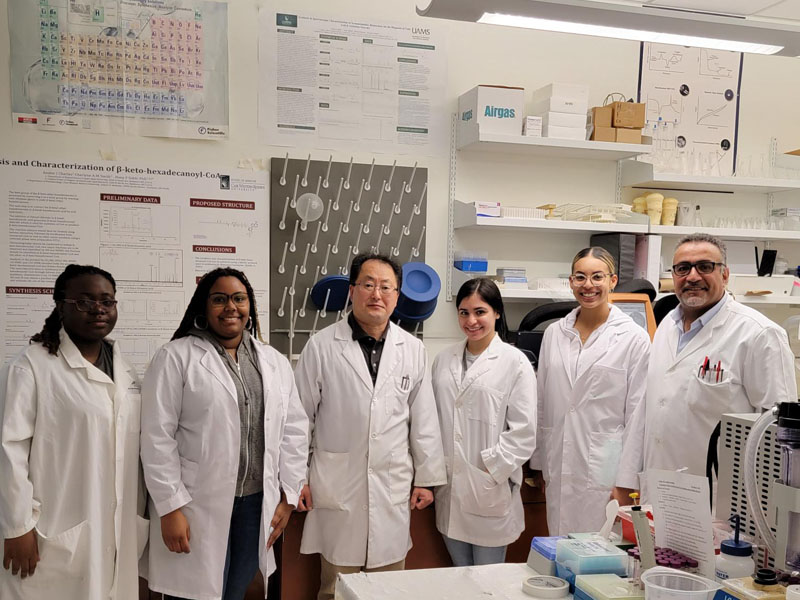
The Center for Organic Synthesis was founded in 2011 by Dr. Hany F. Sobhi, Professor of Organic and Clinical Chemistry. The primary objective of the center is to develop strategies to synthesize, purify, and full spectroscopic characterization of small bioorganic molecules that can be used for clinical diagnosis (biomarkers), and to understand the pathogenic mechanisms underlying the clinical manifestations of diseases, that lead to potential new drugs, and/or suggested therapeutic strategy.
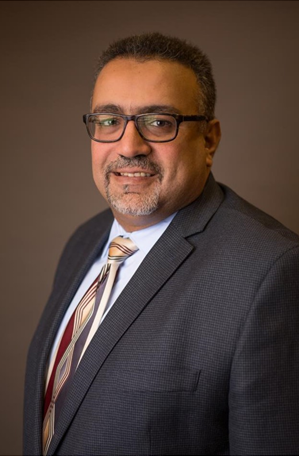
Dr. Sobhi obtained his Ph.D. in Clinical Bioanalytical Chemistry, with a specialization in synthetic bioorganic chemistry from Cleveland State University in 2008. Following his M.S. in Synthetic Organic Chemistry in 2005. In 2008 he was appointed as an NIH Post-Doctoral Fellow, at the Center for Mitochondrial Diseases at the Department of Pharmacology, at Case Western Reserve University, School of Medicine. In 2019 Dr. Sobhi was promoted to the rank of full Professor of organic and clinical chemistry at Coppin State University. Since 2011, Dr. Sobhi has established his research lab (Center for Organic Synthesis).
Shortly after he was awarded the Minority-Serving Institution Faculty Scholar in Cancer Research Awards from the American Association for Cancer Research (AACR). In 2012 Dr. Sobhi received NASA / NAI Astrobiology Faculty Fellowship, and in 2013 he was awarded the NAP-NASA/ MIRS- Award 2013 and was appointed as visitor scientist at NASA. In 2015 Dr. Sobhi was awarded the Wilson H. Elkins Professorships, from the University System of Maryland. Furthermore, Dr. Sobhi is the recipient of the 2015/2016 University System of Maryland Board of Regents Faculty award USM/ BOR Board for excellence in research and innovation. For the past eleven years the center for organic Synthesis had received several grants from National institute of Health (NIH), Department of Defense (DOD), and USDA, to support the ongoing research efforts.
Dr. Sobhi research team is all undergraduate chemistry and biology students, and he engages his students in the research projects and, secure funds for student’s research scholarships. The primary objective of Dr. Sobhi’s research is to develop strategies to synthesis small bioorganic molecules that can be used for clinical diagnosis (biomarkers) and understand the pathogenic mechanisms underlying the clinical manifestations of diseases which could be clinically useful in treatment. Dr. Sobhi is also interested in the development bio-active organic scaffolds for more efficient drug delivery that targeted hepatic therapy and the development of intelligent carrier using nanotechnology.
Dr. Sobhi has published numerous papers in peer-reviewed journals and has presented his research at national and international conferences. Dr. Sobhi is an active member of several professional scientific research organizations. Currently his most recent publication received an honorary award by the American Physiological Society for APSselect (http://apsselect.physiology.org/) and has been selected as one of the best recently published articles in Physiological Research. Dr. Sobhi had extend Coppin State University outreach and research network to several local national and international research institution, and he established network of collaborators with federal agencies, such as NASA/ GSFC department of defense DOD Army Research lab.

March 29, 2020: Ms. Brittany Henly (Junior, Chemistry Major) awarded at the American Chemical Society's 42nd Annual Student Award Ceremony for excellence in undergraduate research in chemistry. Ms. Henly's research involves the synthesis and characterization of medium chain fatty acids using GCMS, NMR analysis.

The Center for Organic Synthesis was founded in 2011 by Dr. Hany F. Sobhi, Professor of Organic and Clinical Chemistry. The primary objective of the center is to develop strategies to synthesize, purify, and full spectroscopic characterization of small bioorganic molecules that can be used for clinical diagnosis (biomarkers), and to understand the pathogenic mechanisms underlying the clinical manifestations of diseases, that lead to potential new drugs, and/or suggested therapeutic strategy.

Dr. Sobhi obtained his Ph.D. in Clinical Bioanalytical Chemistry, with a specialization in synthetic bioorganic chemistry from Cleveland State University in 2008. Following his M.S. in Synthetic Organic Chemistry in 2005. In 2008 he was appointed as an NIH Post-Doctoral Fellow, at the Center for Mitochondrial Diseases at the Department of Pharmacology, at Case Western Reserve University, School of Medicine. In 2019 Dr. Sobhi was promoted to the rank of full Professor of organic and clinical chemistry at Coppin State University. Since 2011, Dr. Sobhi has established his research lab (Center for Organic Synthesis).
Shortly after he was awarded the Minority-Serving Institution Faculty Scholar in Cancer Research Awards from the American Association for Cancer Research (AACR). In 2012 Dr. Sobhi received NASA / NAI Astrobiology Faculty Fellowship, and in 2013 he was awarded the NAP-NASA/ MIRS- Award 2013 and was appointed as visitor scientist at NASA. In 2015 Dr. Sobhi was awarded the Wilson H. Elkins Professorships, from the University System of Maryland. Furthermore, Dr. Sobhi is the recipient of the 2015/2016 University System of Maryland Board of Regents Faculty award USM/ BOR Board for excellence in research and innovation. For the past eleven years the center for organic Synthesis had received several grants from National institute of Health (NIH), Department of Defense (DOD), and USDA, to support the ongoing research efforts.
Dr. Sobhi research team is all undergraduate chemistry and biology students, and he engages his students in the research projects and, secure funds for student’s research scholarships. The primary objective of Dr. Sobhi’s research is to develop strategies to synthesis small bioorganic molecules that can be used for clinical diagnosis (biomarkers) and understand the pathogenic mechanisms underlying the clinical manifestations of diseases which could be clinically useful in treatment. Dr. Sobhi is also interested in the development bio-active organic scaffolds for more efficient drug delivery that targeted hepatic therapy and the development of intelligent carrier using nanotechnology.
Dr. Sobhi has published numerous papers in peer-reviewed journals and has presented his research at national and international conferences. Dr. Sobhi is an active member of several professional scientific research organizations. Currently his most recent publication received an honorary award by the American Physiological Society for APSselect (http://apsselect.physiology.org/) and has been selected as one of the best recently published articles in Physiological Research. Dr. Sobhi had extend Coppin State University outreach and research network to several local national and international research institution, and he established network of collaborators with federal agencies, such as NASA/ GSFC department of defense DOD Army Research lab.

March 29, 2020: Ms. Brittany Henly (Junior, Chemistry Major) awarded at the American Chemical Society's 42nd Annual Student Award Ceremony for excellence in undergraduate research in chemistry. Ms. Henly's research involves the synthesis and characterization of medium chain fatty acids using GCMS, NMR analysis.
This Maryland State Department of Education (MSDE)-approved 18- hour program focuses on preparing currently licensed teaching professionals for school leadership positions. Graduates finish with the experience of putting theory into practice, and meet the MSDE academic requirements for the School Administrator I certification to become assistant principal.
The Maryland State Department of Education (MSDE) has specific requirements to become a school principal or administrator in the State of Maryland. The certification makes sure eligible professionals have a solid grounding in curriculum and instruction supervision, personnel management, program administration laws and regulations along with practical experience. Please note, in addition to program completion, you must also submit other MSDE-required documentation to be fully eligible to become an assistant principal.
This program is designed for education professionals who want to grow their skills outside of the classroom, and transition to a school leadership role. Specifically, prospective students must have a:
| Course | credits | Name |
|---|---|---|
| EDUC 646 | 3 | Human Relations and Interpersonal Communications |
| EDUC 655 | 3 | Supervision of Instruction |
| EDUC 701 | 3 | School Law |
| EDUC 705 | 3 | Strategies for Curriculum Development |
| EDUC 707 | 3 | Administration of Education Programs |
| EDUC 667 | 3 | Internship in Education Administration |

The Coppin State University Academic Catalog has a wide variety of skill-building courses designed to inspire and prepare you to be in-demand professionals and transformational leaders.
The School Administration certificate is in the Department of Instructional Leadership and Professional Development in the School of Education within the College of Arts & Sciences, and Education.